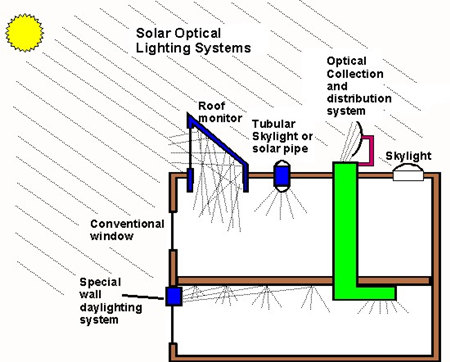
![]()
![]() A variety of solar illumination systems can be used for lighting
the interiors of buildings. Some are designed to introduce sunlight to the
perimeter spaces, or to the top floor of a multistory building. Others
target the interior spaces of multistory buildings, spaces well removed
from the building envelope where conventional windows and skylights could
be used for daylight illumination. Several U.S. companies are developing
products for this new field. Below is a graphic illustrating the varied
options.
A variety of solar illumination systems can be used for lighting
the interiors of buildings. Some are designed to introduce sunlight to the
perimeter spaces, or to the top floor of a multistory building. Others
target the interior spaces of multistory buildings, spaces well removed
from the building envelope where conventional windows and skylights could
be used for daylight illumination. Several U.S. companies are developing
products for this new field. Below is a graphic illustrating the varied
options.
Many attempts to make solar lighting a technical and commercial success
have not prospered. The reasons in some cases are technical, and in others
the costs are much too high, even for the significant energy and dollar savings
they promise. In spite of these obstacles, however, inventors and small companies
persist in attempting to develop and launch products into this new field.
Even when technical and cost obstacles are overcome, however, there remain
serious additional ones which have so far thwarted expansion of this new
industry in the U.S.

A notable exception is the case of what are known generically as tubular daylighting devices. Better known as tubular skylights, these devices admit daylight through a transparent dome-shaped cover glazing over a reflective cylindrical tube. Sunlight passing through the cover glazing enters the tube and is multiply reflected with only modest light loss down the tube to another glazing at the bottom. This glazing is flush with the ceiling, looks somewhat like a normal light fixture. Being translucent it spreads the light reaching it at the bottom of the tube over a large area of the room below. Tubular daylighting devices (TDDs) can be effective at saving lighting energy when they are installed in buildings occupied for major portions of the daylight hours, when electric lights might otherwise be on. With sufficient light from these devices, there is little need for lights in the daytime, and the small quantity of solar heat gain admitted by them is generally much less than that produced by electric lights. Daylighting saves energy and dollars first by not having to have the electrical lighting system turned on and second by loading the air conditioning system with less heat gain.As the world passes its peak in oil production, energy prices are expected to increase. Designs for daylighting which might have limited cost-effectiveness in today's market should be more attractive in the future.
